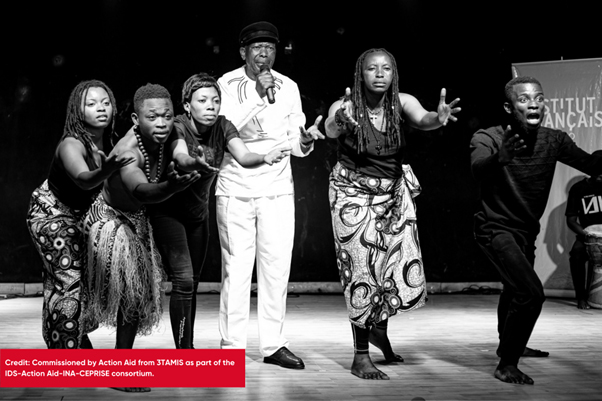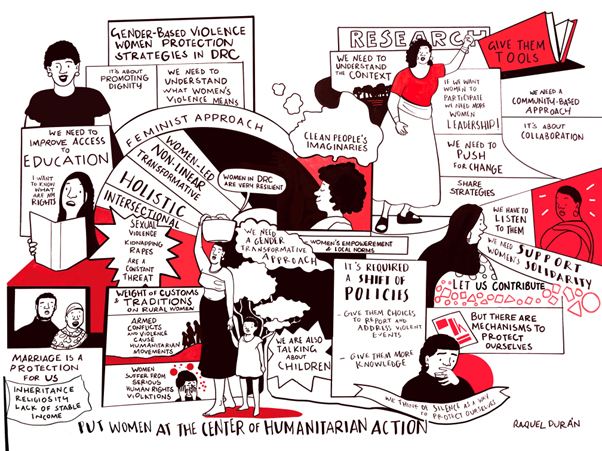On the 25 November, the annual international campaign of 16 Days of Activism against Gender-Based Violence has begun. The UK is also hosting the Preventing Sexual Violence in Conflict Initiative (PSVI) conference where it will look at how to strengthen the global response to Conflict-Related Sexual Violence (CRSV). A transdisciplinary project led by the Institute of Development Studies (IDS) has looked more closely at the relationship between humanitarian protection and gender-based violence.
Gender-based violence in contexts of violent conflict has gained recognition in international policy discourse. Over the past decades, eastern Congo has been depicted as a place of continuing conflict, where “sexual violence was a daily reality from which Congolese women gained no respite”. The scale and brutality of violence were essentially explained through the concept of ‘rape as a weapon of war’. Defined by the United Nations as “a military tactic, serving as a combat tool to humiliate and demoralize individuals, to tear apart families, and to devastate communities”, this concept acquired such traction that it became the foundation of the UN resolution 1325 on Women, Peace and Security (2000).
In 2018, Denis Mukwege received the Nobel Peace Prize for his effort to end sexual violence in DRC, drawing further attention to the issue of sexual and gender-based violence in the country. Though well intentioned, this increased focus has come at a cost. Whilst it has increased awareness and funding for humanitarian action on violence against women in DRC, it also restricted the focus to sexual violence committed by weapon bearers. For many in the humanitarian, development and peacebuilding circles, the ‘rape as a weapon of war’ narrative limited the experiences of women to only one form of gender-based violence (rape) and obscured other forms of structural violence perpetrated by non-armed actors, in indirect or post-conflict setting, or outside of war areas.
To better understand how these narratives have evolved, a transdisciplinary project led by the Institute of Development Studies (IDS) worked closely with women’s groups in North and South Kivu to explore the meaning of the notion of humanitarian protection and gender-based violence. The New Community-Informed Approaches to Humanitarian Protection project also used art (photography, theatre, dance, percussion, music, painting, writing and slam) to explore vernacular understandings of protection and gender-based violence.
Women’s agency in approaches to humanitarian protection and gender-based violence

The protection of civilians is a fundamental principle in humanitarian policy and practice, and it has become a priority for many humanitarian organisations. While protection strategies have traditionally been top-down, reactive, and often militaristic, recent approaches have increasingly focused on community-led and ‘bottom-up’ forms of protection, focusing on the self-protection strategies of civilians in contexts of insecurity and violent conflict.
Women groups in eastern DRC will attest to the fact that despite experiencing multiple forms of violence and vulnerability resulting from militarisation and the persistence of longstanding restrictive gender norms in various contexts, women do exercise individual and collective agency to secure protection and their economic and social interests. Understanding the different ways women exercise agency to secure self-protection is therefore key to deepen our knowledge on women’s agency in protracted conflict contexts.
Protection and security are polysemic notions, whose meaning changes according to societal and cultural contexts. The project found that westernised definitions of protection or international standards promoted by INGO protection projects do not adequately capture protection risks as identified by women, and rely on heteronormative assumptions and Eurocentric conceptions of gender roles deployed to change Congolese society and norms.

At the same time, the project found that despite restrictions imposed upon women, many are active in women’s leadership groups promoting women-led approaches to protection in conflict settings. Women’s groups and women’s participation and leadership in local structures can act as a pathway towards a greater presence in decision-making spaces, women’s emancipation and gender equality. These spaces, therefore, provide a platform through which women can collectively advocate for their rights within Congolese law, provide support when addressing state authorities, the police, the military or armed actors.
However, what is apparent is that the protection strategies of women are highly context-dependant and reliant on the existing networks and entourage of women. Approaches that are built on conceptions and strategies that are largely external to the contexts in which they are implemented are often short lived, inefficient, or can expose women to further risks. A better understanding of the social and cultural contexts is required to shift away from simply responding to GBV to finding ways to support women to challenge and address issues of GBV.
Overall, the creation of channels for women to develop leadership skills and the establishment of other support forums enabled women to publicly contribute to community protection plans, and advocate for their protection needs with various local authorities and state actors. As shown in our research, women learned how to use legal frames, informal networks to access leaders, and developed new alliances. These practices have created the possibility for slowly changing gender norms around women’s access and presence in decision making, ideas around women’s protection needs and rights and to challenge the culture of silence around violence. However, our findings from North and South Kivu, shows that the pathways to enhance women’s agency in settings experiencing protracted conflict are not without challenges.
It is essential, therefore, for protection approaches to build on the protection strategies that are used and deployed by women in their daily lives and local forms of knowledges, especially that held by women, and to prioritise strategies that have proved successful in such contexts rather than importing new approaches. This is in line with a decolonial approach, where we need to pay attention to vernaculars of protection (to avoid epistemological violence) and focus on what women say are their priorities.
Holistic approaches on the role of the community as allies, supporting against backlash and risk-sharing are strategies that need to be put in place and conversations within the INGO community have begun. Current and mainstream approaches to gender equality usually focus mostly on changing the ‘cultural’ aspects of gender relations, without questioning the broader structural issues (link to poverty and lack of economic empowerment, especially in relation to inheritance, dowry, land ownership). A truly transformative approach needs to focus on the structural factors more broadly, not just social norms, and therefore tackle poverty, combining gender protection with other forms of vulnerabilities and conflict around inheritance, dowry, and land ownership. Failure to do so will only entrench western epistemologies that fail to prioritise the voices of those affected.
If you would like more information on this project, please explore the project’s resources:
- Read our working paper
- Follow our Medium blog (French)
- Explore our photography and art work
- Watch our videos
*This blog is based on the IDS Working Paper, ‘Women’s Agency and Humanitarian Protection in North and South Kivu, DRC’.